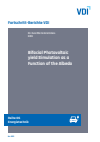Bifacial Photovoltaic yield Simulation as a Function of the Albedo
Zusammenfassung
Die Bifacial-Photovoltaik-(PV-)Technologie markiert einen bedeutenden Fortschritt im Bereich der Solarenergie. In der vorgelegten Dissertation wird mit BifacialSimu ein innovatives, ganzheitliches Open-Source-Simulationstool für die Energiesystemsimulation von bifazialen Photovoltaik-Systemen präsentiert. Dieses Tool unterscheidet sich signifikant von existierenden Methoden durch die Integration eines umfassenden Analyseansatzes, der die Albedo berücksichtigt und spezialisierte Lösungsstrategien für diverse Anwendungsgebiete, einschließlich agrarwirtschaftlicher PV-Installationen, bietet. Dadurch leistet die Dissertation einen bedeutenden Fortschritt in der photovoltaischen Forschung und Praxis, indem sie den Zugang zu fortgeschrittenen Simulationswerkzeugen demokratisiert und die Effizienzsteigerung sowie Optimierung bifazialer PV-Systeme unterstützt. Index 1 Introduction 1 1.1 Motivation . . . . . . . . . . . . . . . . . . . . . . . . . . . . . . . . . . . . . . 1 1.2 Research objectives and approach . . . . . . . . . . . . . . . . . . . . . . . . 3 1.3 Dissertation outline . . . . . . . . . . . . . . . . . . . . . . . . . . . . . . . . . 4 2 State of the...
Schlagworte
- Kapitel Ausklappen | EinklappenSeiten
- I–XVIII Titelei/Inhaltsverzeichnis I–XVIII
- 1–5 1 Introduction 1–5
- 1.1 Motivation
- 1.2 Research objectives and approach
- 1.3 Dissertation outline
- 6–40 2 State of the Art of bifacial PV system modelling 6–40
- 2.1 Parameters that influence rear side irradiance
- 2.2 Sky models
- 2.3 Rear-side irradiance models
- 2.3.1 View factor model
- 2.3.2 Ray tracing method
- 2.3.3 Comparison of different models
- 2.4 Albedo models
- 2.4.1 Constant albedo
- 2.4.2 Simplified variable albedo model
- 2.4.3 Geometrical spectral albedo model
- 2.4.4 Further factors influencing the albedo
- 2.5 Bifacial tracking models
- 2.5.1 1-axis tracking
- 2.5.2 Backtracking
- 2.5.3 2-axis tracking
- 2.6 Thermal model
- 2.7 Soiling models
- 2.7.1 Bergin model
- 2.7.2 You model
- 2.7.3 Coello model
- 2.7.4 Adaptation for bifacial PV modules
- 2.8 Energy yield models
- 2.8.1 Analytical electrical model
- 2.8.2 Empirical electrical model
- 2.9 Availability of weather and albedo datasets
- 2.10 Determining model and database selection
- 41–51 3 Research methodology and procedure 41–51
- 3.1 Design of the simulation tool
- 3.2 Albedo measurement setup
- 3.3 Global Sensitivity Analysis
- 3.4 Validation method
- 52–74 4 BifacialSimu - Holistic bifacial PV system modelling 52–74
- 4.1 Bifacial PV modelling challenges
- 4.2 Simulation algorithm design
- 4.3 Modelling method
- 4.3.1 Bifacial PV irradiance model
- 4.3.2 Sky model
- 4.3.3 Albedo model
- 4.3.4 Single-axis tracking model
- 4.3.5 Soiling model
- 4.3.6 Electrical model
- 4.3.7 Thermal model
- 4.3.8 Performance indicators
- 4.4 Graphical User Interface
- 75–86 5 Measurement of the albedo 75–86
- 5.1 Measurement of red soil in Ghana
- 5.2 Measurement at TH Ko¨ ln
- 5.3 Measurement at Agri-Photovoltaic system in Aasen
- 5.4 Uncertainty analysis
- 87–107 6 Model validation on specific fields 87–107
- 6.1 Study 1: Validation of the irradiance models
- 6.1.1 Evaluation of the results from a PV plant in USA
- 6.1.2 Evaluation of the results from PV plant in Germany
- 6.1.3 Conclusion study 1
- 6.2 Study 2: Validation with a vertical fixed-tilt agriphotovoltaic plant
- 6.2.1 Evaluation of the results from an agriphotovoltaic plant
- 6.2.2 Conclusion study 2
- 6.3 Study 3: Validation with miniaturised bifacial PV modules
- 6.3.1 Design and construction
- 6.3.2 Evaluation of the results
- 6.3.3 Study 3 uncertainties
- 6.3.4 Conclusion study 3
- 6.3.5 Improvement of the miniaturised modules
- 6.4 Study 4: Validation of model for electrical losses
- 6.4.1 Evaluation of electrical results from comparison with PVSyst
- 6.4.2 Conclusion study 4
- 6.5 Study 5: Evaluation of methods for optimizing a ray tracing simulation
- 6.5.1 Evaluation of the results from the GSA
- 6.5.2 Conclusion study 5
- 108–125 7 Validation of the yield simulation of bifacial PV systems 108–125
- 7.1 Validation datasets
- 7.1.1 Dataset: Golden, USA
- 7.1.2 Dataset: Floriano´ polis, Brazil
- 7.1.3 Dataset: Heggelbach, Germany
- 7.2 Model optimisation
- 7.2.1 Simulation assessment
- 7.2.2 Bugfixing
- 7.2.3 Simulation of module temperature
- 7.2.4 Simulation speed optimisation
- 126–156 8 Discussion 126–156
- 8.1 Performance of the module with fixed tilt
- 8.1.1 Heggelbach, Germany
- 8.1.2 Floriano´ polis, Brazil
- 8.1.3 Conclusion: Simulation with fixed tilt
- 8.2 Performance of the module with single-axis tracking
- 8.2.1 Floriano´ polis, Brazil
- 8.2.2 Golden, USA
- 8.2.3 Conclusion: Simulation with single-axis tracking
- 8.3 Performance of the albedo model under snow condition
- 8.4 Performance of the modules with different albedo modes
- 8.5 Performance of the modules with field and simulated weather data
- 8.6 Performance of ray tracing and cumulative sky simulation
- 8.7 Performance of the module with different electrical modes
- 8.8 Comparison with Commercial Software PVSyst
- 157–162 9 Conclusion and perspectives 157–162
- 9.1 Conclusion on the novelty of this thesis
- 9.2 Conclusion on the validation of specific models in BifacialSimu
- 9.3 General conclusion and outlook
- 163–163 APPENDICES 163–163
- 163–164 A Simulation Models 163–164
- 165–171 B BifacialSimu Code 165–171
- 8.1 Multiprocessing
- 8.2 Albedo model
- 8.3 Soiling model
- 172–179 C Description of Graphical User Interface 172–179
- C.1 GUI: Simulation Parameters
- C.2 GUI: Soiling
- C.3 GUI: Simulation Control
- C.4 GUI: Module Parameters
- C.5 GUI: Wire Parameter
- C.6 GUI: Inverter Parameter
- C.7 GUI: Start Simulation
- 180–189 D Additional Validation 180–189
- D.1 Validation: Golden, USA
- D.2 Validation: Heggelbach, Germany
- D.3 Optimisation: Simulation assessment
- D.4 Validation: Simulation parameter
- D.5 Discussion: Error estimation in Golden, USA
- 190–220 REFERENCES 190–220


